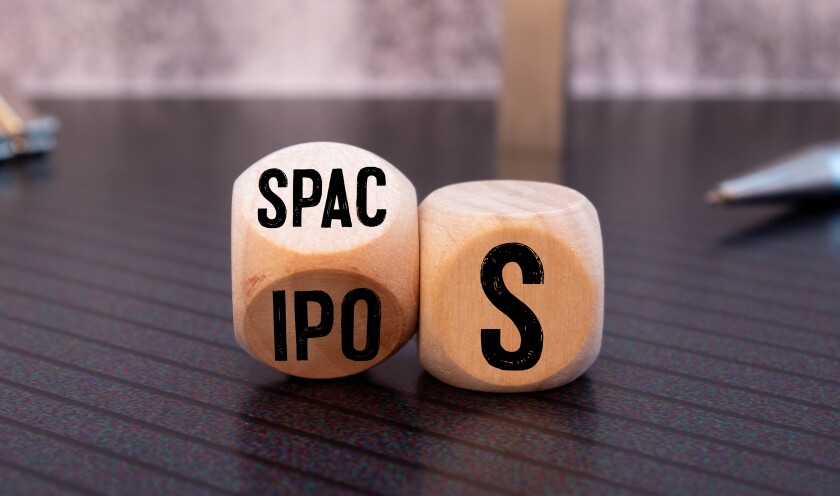The small but encouraging SPAC revival on US markets offers law firms the opportunity to engage in a combination of transactional and regulatory work and bolster profitability, experts say.
While this returning momentum is nowhere near the volumes recorded 2021 – when the total value of SPAC deals in the US amounted to more than $162 billion – the uptick recorded so far in 2025 brings cautious optimism.
In a recent article on IFLR, we reported that so far this year, 48 SPACs have been recorded in the US, raising around $10.1 billion.
Here we speak with Brian Hirshberg, partner in the capital markets group at Mayer Brown in New York, and Daniele D’Alvia, lecturer in banking and finance law at the Centre for Commercial Law Studies (CCLS) at Queen Mary University in London (QMUL), who is also deputy director of the Institute of Banking and Finance Law at CCLS QMUL.
We discuss the current state of SPAC activity in the US, what is driving it and the impact of the Securities and Exchange Commission (SEC) rules update.
Profitable game
The multifaceted nature of SPAC work makes it particularly appealing for law firms, says D’Alvia.
“SPACs offer a combination of business opportunities including, advising the underwriters, the SPAC sponsor and even advising on the M&A transaction in the de-SPAC,” he tells IFLR.
“By advising both during the IPO and later in the M&A stage, there's more room for negotiation and potentially better fees,” he continues.
D’Alvia’s academic work focuses on positioning special purpose acquisitions within the broader legal and historical context, arguing that they are not “backdoor listings”. In his work, he also challenges the notion that businesses that opt for a SPAC transaction are “blank check” companies.
For D’Alvia, one of the key advantages of such transactions is that they potentially offer more profitability to lawyers and law firms alike.
“They are a legitimate alternative to IPOs,” he says. “For lawyers and law firms that are just approaching the subject, my advice is to enter the market because it is very interesting .”
‘Back’ is a term of context
At Mayer Brown, Hirshberg says he and his team are currently working on a number of SPACs transactions, but commenting on market activity, he argues that “back is a term of context”.
He stresses that today’s SPACs levels aren’t back to 2021 to 2022 ones – and they may never be.
“But they’ve existed for decades prior to that and go through up and low cycles,” he explains.
“Over the past couple of months, there’s been an uptick, similar to IPO activity, despite ongoing market volatility. Time will tell if these deals do indeed close.”
D’Alvia agrees and says that he expects the SPAC momentum to continue throughout this year but doesn’t predict that it will ever reach the levels of the past.
The surge in 2020 to 2021 was fuelled by unprecedented liquidity made available during the Covid-19 pandemic, and a search for yield in the low interest rate environment. But the rapid decline was equally dramatic.
“Two key challenges followed,” says Hirschberg.
“High redemption rates – sometimes exceeding 90% – which drained SPAC escrow accounts, and difficulties executing private investment in private equity (PIPE) transactions. Many of those PIPE deals underperformed in aftermarket trading, discouraging future investment.”
For D’Alvia, the post-2021 decline revealed structural weaknesses in the transactions, such as misaligned incentives, unrealistic projections from target companies and insufficient due diligence.
“What we saw was not the failure of the SPAC model per se, but rather a failure of how it was being deployed at scale without appropriate governance safeguards,” he adds.
“In other words, it is clear that a Hollywood star cannot direct a SPAC – quality of the management and sponsors is key in the SPAC market.”
Not a Hollywood business
During the SPAC frenzy, billion-dollar deals were driven by celebrity endorsement and broad retail investor enthusiasm, but when reality set in, many underperformed.
At that time, the main actors in SPAC transactions were big investment banks, like Deutsche Bank, Citibank, JP Morgan and Goldman Sachs.
“But they saw that there are a lot of liabilities in that process,” D’Alvia recalls.
Today, SPAC deals involve smaller investment banks and seasoned SPAC sponsors.
For D’Alvia this marks a notable shift.
“As regulatory risk and reputational scrutiny intensified, larger banks recalibrated their SPAC involvement,” he explains.
That’s where smaller and regional investment banks saw an opportunity.
“They are more agile and willing to underwrite niche or cross-border deals that bigger firms may now deem too risky,” D’Alvia adds.
Shifting narrative
In 2024, the SEC adopted new rules that reshaped the legal framework concerning SPAC IPOs and de-SPAC transactions.
For D’Alvia, the new framework provided both a filter and a signal.
He notes that for sponsors, stricter liability standards and disclosure requirements have filtered out less committed players, leaving only serious market participants.
As for underwriters, some have become more cautious now that their liability post-merger has been clarified, but mid-sized banks are stepping in as bigger firms pull back.
“The reforms have enhanced legal certainty but also shifted the SPAC narrative from being purely financial to being legally accountable, which I view as a positive evolution,” D’Alvia notes.
The new SEC rules published last year also aligned traditional IPO and de-SPAC disclosure requirements, including requirements for the target company to be a co-registrant in certain filings and minimum dissemination time periods, among others.
“Hopefully, comments on de-SPAC registration statements will be practical and supportive of capital formation and deal execution,” says Hirschberg.
For D’Alvia, this move was “truly remarkable”.
“Following 100 years of the Securities Act 1933 and the Securities and Exchange Act 1934, the SEC has planted the seed of a revolution in corporate finance,” he concludes.

